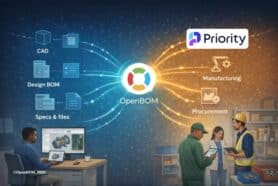
Industrial companies are in the midst of a digital transformation. The influx of data, the distributed character of work and the need to make better decisions faster are putting new pressure on manufacturers. At the same time, companies are relying on spreadsheets and outdated legacy systems, and disconnected processes to manage their data. This can lead to frustration and pain when it comes to making decisions about engineering, production, inventory, supply chain, and more.
Legacy PLM Foundation
For many years, PLM systems were presented as a way to control product information and provide support for process management including holistic records of product information through the entire lifecycle, change management, and related processes.
Mature PLM systems are on average 20+ years old and provide a foundation mostly for larger companies with complex products. The presence of these systems is an obvious necessity because there are not many alternatives for companies in the aerospace, automotive, and defense field to build products without them. I recently talked to someone who compared the PLM industry with the airline business. We obviously need to take a flight when we have to go a distance (business or vacation). But the overall experience is not nice and business is very complex.
CIMdata, a leading company in PLM research, published the information about PLM implementation status from their annual survey and, as we can see, companies are still heavily focused on traditional engineering processes by using existing PLM systems.
SaaS PLM Alternatives and PLM paradigm
Industrial companies are finally finding ways to faster adoption of cloud technologies and SaaS applications. Although I can see manufacturing businesses are very much behind SaaS adoption in an engineering software system, the trend is very positive and according to research made by Gartner and CIMdata, the industry is moving to cloud-native software in both SME and enterprise segments of the market.
At the same time, SaaS by itself doesn’t solve the problem. By taking a legacy system or its SaaS siblings and getting access to them via cloud servers, companies only can solve some problems. Most of these problems are related to IT infrastructure, setup, configurations, and upgrades. While it is an important thing by itself, most PLM systems delivered from the cloud are not different in the way they provide support to data management and release process. The same engineering process focus and existing data control paradigm stay in touch and the cloud PLM system in many examples washed down to a “cheap alternative of big PLM”.
Network, System of Intelligence, and Decision Support
What are traditional PLM systems missing in the current landscape of offered PLM solutions? At OpenBOM we’ve been rethinking some of the fundamentals of PLM paradigms and decided to change them by offering new architecture of the system and new values the future PLM will be delivering to manufacturing companies.
Networks and Multi-Tenancy
All legacy PLM and many SaaS PLM systems are focused on a single tenant paradigm and single database-driven system to deliver solutions to a single company. This means PLM controls the data, and lifecycle and allows all company users to work together. At the same time, modern manufacturing is adopting a network paradigm in which companies are working together to deliver products. A big mismatch between how companies work and product lifecycle management systems are operating.
OpenBOM brings a fundamental shift by introducing a multi-tenant approach to data management, data sharing, and collaboration. A network layer in OpenBOM allows multiple teams and companies to work together, share data and communicate more efficiently including running cross-team/company processes (eg. change process between OEM and Tier 1 supplier).
Multi-tenant data architecture combined with modern data management and analytics can bring new capabilities and values. OpenBOM is leveraging modern NoSQL and Graph database architecture to deliver data model flexibility and analytics to OpenBOM solutions.
Intelligence and Decision Support
Old fashion product data management allowed the management of data and business processes but provided little to no support for data analytics, and decision support. Capturing a large amount of data from product development, supply chain management, and online data helps to turn the system towards decision support such as cost analysis, supply chain bottlenecks, sustainability, and regulation.
By providing real-time data and analytics to engineers and all other people involved in the product development process, we allow changing business process upside down. For example, by getting real-time cost assessment and components availability, OpenBOM helps engineers to make better decisions earlier in product development.
Conclusion:
OpenBOM’s vision is to build a digital thread and system of intelligence for industrial companies and supply chains. We are changing the role of the PLM system from being a data locker of product records to becoming a system of intelligence capable of collecting, analyzing, and inferring a variety of information from industrial companies, their supply chain, contractors, and online data sources to help companies to make an intelligent informed decision. This is a paradigm shift we are working towards.
Want to talk about how to make a paradigm shift in your business processes? Contact us and we would be happy to talk.
REGISTER FOR FREE and try our 14-day trial to get an inside look at how OpenBOM can help you and your organization today.
Best, Oleg
Join our newsletter to receive a weekly portion of news, articles, and tips about OpenBOM and our community.










